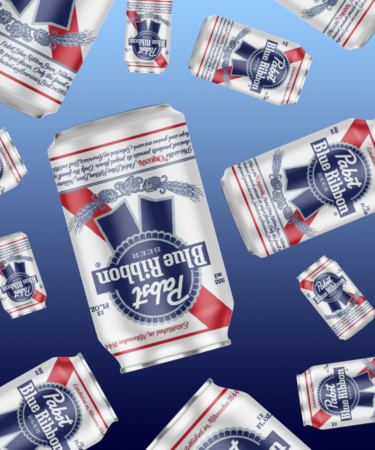While the company does not act like a traditional brewer (and in fact does not actually brew beer) and has experienced uncertainty in the past few years, Pabst Brewing, based in Los Angeles, is the fifth-largest in the U.S. Established in 1844 in Milwaukee and best-known for its Pabst Blue Ribbon brand, the brewery currently claims 30 brands to its name.
But Pabst’s nearly 180-year history — and its most popular brand’s 2010s-era hipster revival — can be difficult to pin down. To make sense of it all, we’ve put together 11 things you should know about Pabst Blue Ribbon and the company that created it.
Pabst Died And Was Resurrected.
The original Pabst brewery in Milwaukee shuttered in 1996, bringing the brewery’s then-152-year history to a close. However, an investor known for invigorating companies, C. Dean Metropoulos, purchased the brand for a reported $250 million in 2010. Pabst went on the market again in 2014 and was acquired by Blue Ribbon Intermediate Holdings LLC, a partnership between Eugene Kashper, a beer entrepreneur and Pabst’s current chairman and CEO, and San Francisco private equity firm, TSG Consumer Partners, for a reported $700 million. The company is now headquartered in Los Angeles.
PBR: Milwaukee-Brewed…By MillerCoors.
PBR, along with Pabst’s legacy beers, is currently brewed in Milwaukee by MillerCoors. The contract was set to end in 2020, and MillerCoors attempted to terminate the deal at that time. But PBR filed a $400 million lawsuit, and the companies reached a settlement to continue joint operations while the jury was deliberating. The terms of the agreement are unknown, but it appears PBR is safe, for now.
PBR Is More Like A Marketing Agency Than A Brewery.
With all brewing operations outsourced to MillerCoors, Pabst Blue Ribbon serves as an advertising agency for its eponymous beer. Brand equity is paramount, and the company is focused on maintaining competitive strategies related to marketing and distribution.
Aye, Aye, Captain!
The brand is named after Captain Pabst, who took over as president of the brewery in 1872 after marrying Maria Best, daughter of one of the original owners, Phillip Best. At the time, the brewery was called Best and Company.
Pabst Was One Of The First Breweries With An Ice Machine.
The company embraced technology by adopting artificial ice machines in 1880, lit facilities with incandescent lights in 1882, and was one of the first brewers to host public tours. As a pioneer in the nationwide advertising landscape, Captain Pabst’s ingenuity and advanced marketing skills propelled the brand into the national consciousness.
The Blue Ribbon Was Real.
In 1872, Best and Company was the second-largest brewery in the U.S. One of its brands, Best Select, picked up awards at beer competitions throughout the 1880s, so, in 1882, Pabst and his team added pieces of blue ribbons to dress up the Best Select bottles.
The deal was sealed in 1892, when Pabst purchased almost 1 million feet of ribbon to be tied by hand around each Best Select beer. “Blue Ribbon” was added to the beer name in 1895 and, in 1899, the brand name changed to Pabst Blue Ribbon, as we know it today.
Pabst Singles?
Pabst stayed alive during Prohibition as a cheese-making business. Pabst-ett, as the operation was called, was eventually purchased by Kraft.
Pabst Went Ham For The Holidays.
Pabst sold 99-can cases of PBR for the holidays in 2017. The bummer: It was only availabl in Canada.
Pabst May Have Invented The Six-Pack.
According to the American Beer Museum blog, Pabst is believed to be the first brewer to package beer in packs of six. This practice allegedly caught on after a study determined six beers was the ideal weight for the average housewife to hoist home from a store. An alternative explanation was that six-packs fit snugly in the standard paper grocery bag. (Other theories posit Ballantine, Coca-Cola, and a German immigrant brewmaster, William Ostner, as the six-pack’s original creator.)
Pabst Is Big In China.
Pabst owns 30 different beer brands. Some recognizable names include Old Milwaukee, Colt 45 Malt Liquor, and Schlitz. But Pabst also owns Tsingtao, one of China’s most popular beers.
Nobody Puts Pabst In A Corner.
Pabst Blue Ribbon built a following as a working man’s beer and proudly claims to be “union made,” but the brand was revitalized when urban hipsters made the label fashionable in the early 2000s. Always on top of marketing trends, the brand appeals to a variety of tastes with its efforts to drive demand. Watching old commercials from the ‘70s is like opening a time capsule that reveals PBR’s strategic approach to marketing, (and a glimpse into how the world looked 50 years ago) as the company gave Patrick Swayze one of his first acting jobs, and hired bodybuilder Frank Zane for a spot.
